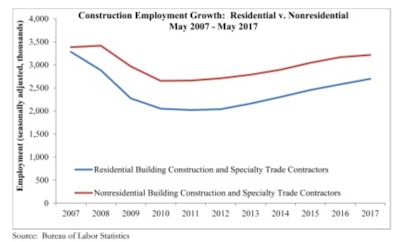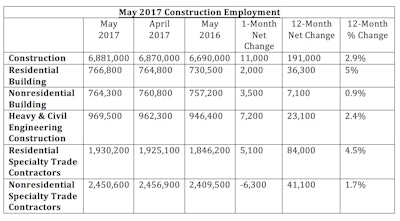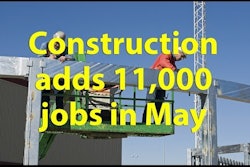
National construction employment added 11,000 net new jobs on a seasonally adjusted basis in May according to Associated Builders and Contractors (ABC) analysis of U.S. Bureau of Labor Statistics data. The nonresidential construction sector added 4,400 net new jobs in May after losing 1,000 net jobs in April (revised down from a net increase of 3,200 jobs), while the residential sector added 7,100 net jobs for the month.
Overall construction employment expanded 2.9% on yearly basis, well above the year-over-year growth rate of 1.6% for all nonfarm industries.
“Today’s jobs numbers supply a mixture of good and bad news,” said ABC Chief Economist Anirban Basu. “Overall nonresidential construction industry employment was up, but much of that was due to the heavy and civil engineering component, which can be associated with volatile employment levels from month-to-month. Nonresidential specialty trade contractors collectively shed employment, which is consistent with the weak construction spending numbers released yesterday. Those statistics indicated ongoing softening in construction spending in both private and public segments.
 “Overall nonresidential construction industry employment was up, but much of that was due to the heavy and civil engineering component, which can be associated with volatile employment levels from month-to-month," said ABC Chief Economist Anirban Basu.Bureau of Labor Statistics
“Overall nonresidential construction industry employment was up, but much of that was due to the heavy and civil engineering component, which can be associated with volatile employment levels from month-to-month," said ABC Chief Economist Anirban Basu.Bureau of Labor Statistics
“More worrisome perhaps are statistics related to labor force participation and the construction industry unemployment rate,” said Basu. “The labor force participation fell to 62.7% in May, a multi-month low. There is also evidence that the construction labor market continues to tighten, which implies construction firms will continue to struggle to find workers, particularly at higher skill levels. This means that construction spending growth is decelerating even as labor becomes more expensive. None of this is good from the perspective of profit-margins or aggregate industry profitability.
“The hope is that the observed weakness in spending is brief and largely a result of lingering uncertainty that would be associated with any major political transition,” said Basu. “Financial markets continue to perform brilliantly, implying that investors continue to view economic conditions favorably. With the construction unemployment rate remaining so low one further hopes that more job seekers will be induced to seek employment in the construction trades. Unfortunately, to date that has not happened at sufficient levels. That said, economists remain confident that the next two quarters will be associated with more robust growth, which could help to reinvigorate construction spending momentum.”
The construction industry unemployment rate, which fell 2.1 percentage points last month, declined further in May and now stands at 5.3%. The construction industry unemployment rate is only available on a nonseasonally adjusted basis. Due to seasonal factors, the industry unemployment rate almost always plummets from March to April and continues to decline in May. The national unemployment rate inched down from 4.4% in April to 4.3% in May. The last time the unemployment rate was this low was in May 2001.

















